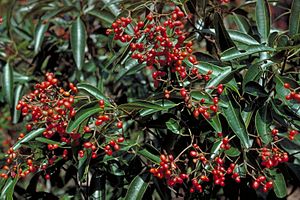Tingletongue facts for kids
Quick facts for kids Tingletongue |
|
|---|---|
 |
|
| Scientific classification | |
| Genus: |
Dinosperma
|
| Species: |
erythrococcum
|
| Synonyms | |
The Tingletongue (scientific name: Dinosperma erythrococcum) is a special kind of tree found only in north-eastern Australia. It's also known by other names like clubwood or nutmeg. This tree usually has leaves made of three parts, arranged in pairs. It also grows small white flowers that turn into bright orange or red fruits. These fruits hold shiny, bluish-black seeds.
Contents
What Does Tingletongue Look Like?
The Tingletongue tree can grow quite tall, sometimes up to 23 meters (about 75 feet)! It's mostly smooth, meaning it doesn't have much hair or fuzz on its surfaces.
Its leaves are usually made of three leaflets, which are like smaller leaves. These leaflets are arranged in pairs along a stem called a petiole, which is about 10 to 30 millimeters long. The leaflets are shaped like a spear or an oval, and they are about 23 to 100 millimeters long and 10 to 30 millimeters wide. You can often see tiny, clear dots on the leaves if you hold them up to the light; these are oil dots.
The flowers of the Tingletongue grow in clusters called panicles, which can be 35 to 90 millimeters long. Each flower has small green parts called sepals, which are about 1 millimeter long. The white petals are about 3 millimeters long. Inside the flower, there are eight stamens, which are the parts that produce pollen. They are about the same length as the petals.
This tree mainly blooms from spring to early summer. After the flowers, it produces small, oval-shaped fruits called follicles. These fruits are orange to red, a little bit soft, and about 6 to 8.5 millimeters long. Inside, you'll find shiny black or bluish-black seeds.
How Tingletongue Got Its Name
In 1858, a scientist named Ferdinand von Mueller first described this plant. He called it Euodia erythrococca. He found specimens of the tree near places like Wide Bay and Moreton Bay in Australia.
Later, in 1997, another scientist named Thomas Gordon Hartley decided that this plant was unique enough to have its own group, or genus, which he named Dinosperma. He then officially moved von Mueller's plant into this new group, giving it the name Dinosperma erythrococcum.
Where Does Tingletongue Grow?
The Tingletongue tree loves to grow in rainforests, especially dry rainforests. You can find it at different heights, from about 60 meters (about 200 feet) up to 1000 meters (about 3,300 feet) above sea level.
It grows in a wide area of north-eastern Australia. Its range stretches from the Iron Range National Park in far north Queensland all the way down to the areas near the Clarence and Richmond Rivers in north-eastern New South Wales. This means it's a plant that is endemic to this part of Australia, meaning it naturally lives nowhere else in the world.
Is Tingletongue Safe?
Good news! The Tingletongue tree is currently listed as being of "least concern" by the Queensland Government. This means that, for now, there are plenty of these trees, and they are not considered to be in danger of disappearing.

